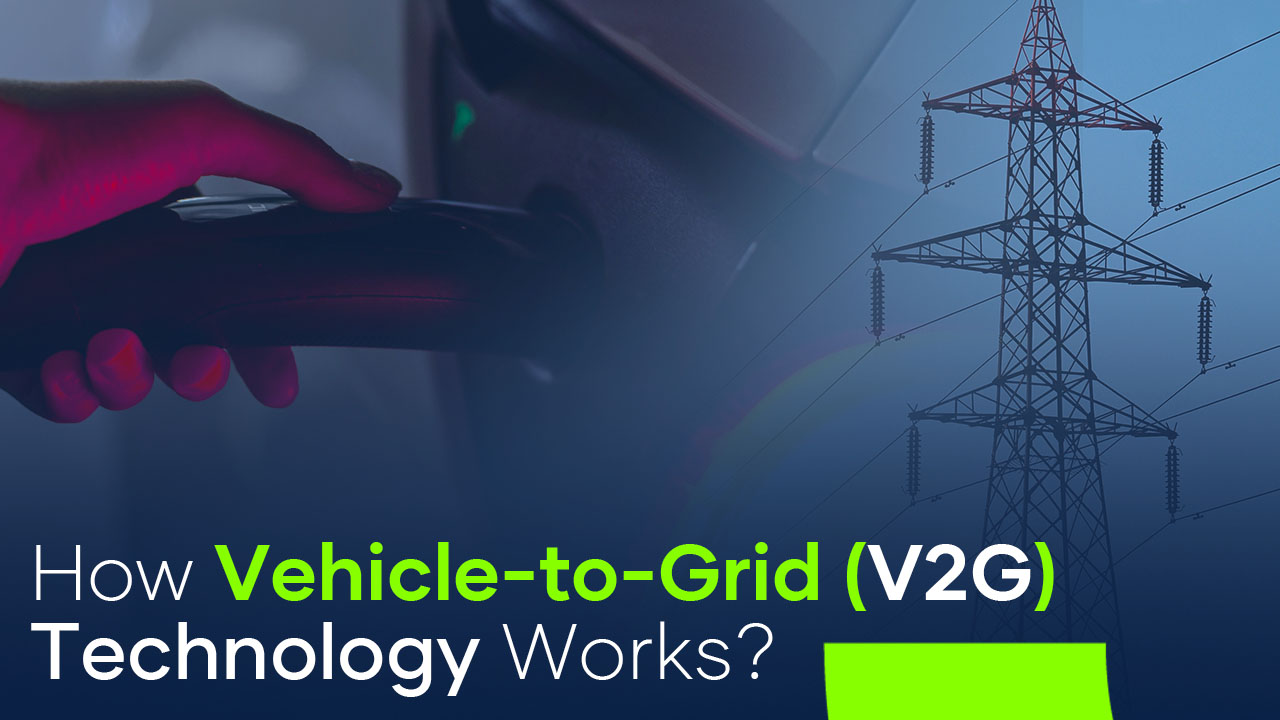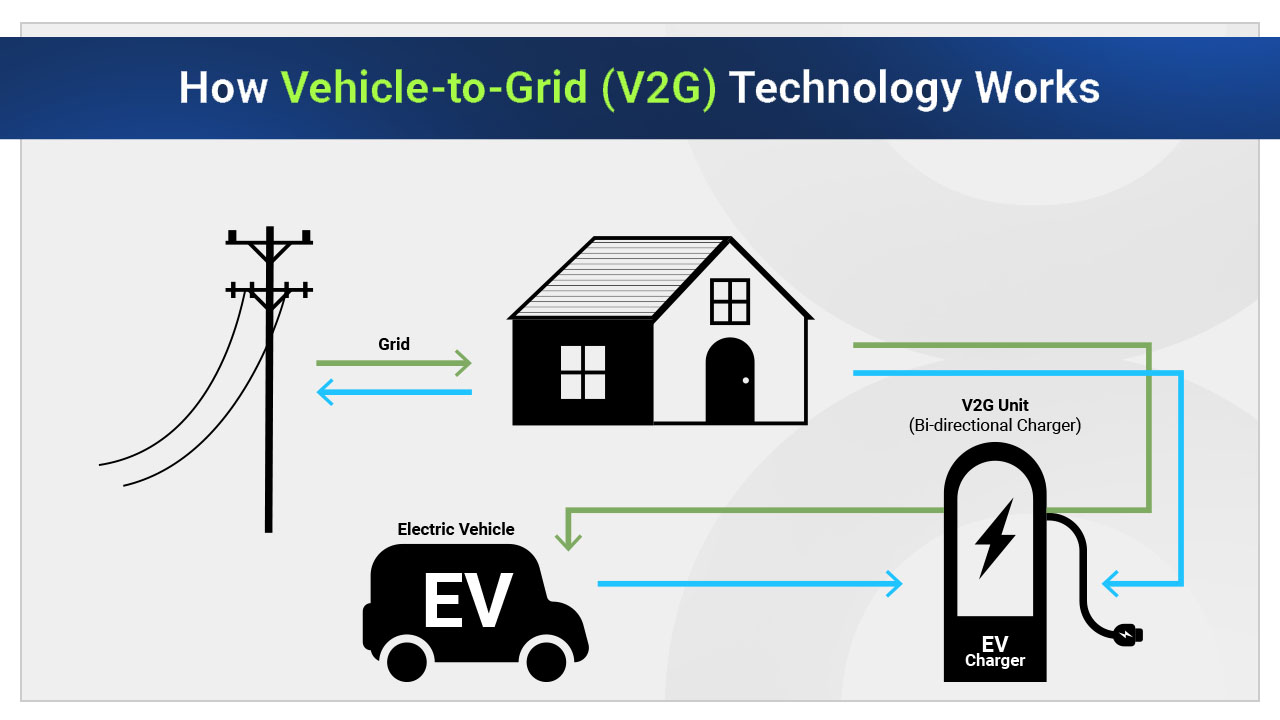The concept of vehicle-to-grid (V2G) technology is changing the way we perceive electric cars. In the United States, there are 2,531,206 electric cars on the roads. (IEA Global EV Outlook 2023) so the energy infrastructure is constantly changing with rapid growth. Consequently, V2G technology is also being upgraded to more sustainable measures.

In this evolving technology allows EVs not only to use electricity but also to store it. They can even send it back into the grid during times of high demand. This process makes the grid more stable.
Furthermore, it lowers costs for both consumers and utilities. However, we discuss the potential benefits of this innovative technology in this blog, specifically how it affects and supports renewable electric power in the form of mobile energy storage systems.
What is vehicle-to-grid charging?
Vehicle-to-Grid (V2G) is a system where EVs and the power grid interact bidirectionally. This system goes beyond simply charging a vehicle. The battery powered the vehicle during off-peak times and discharged back to the grid during high-demand periods.
Moreover, traditional EVs utilize unidirectional charging. This means electricity flows one way: from the “grid to the vehicle.” In contrast, bidirectional charging enables electricity to flow back from the “vehicle to the grid.” Therefore, this two-way flow of electricity allows green vehicles to both use energy efficiently and help stabilize the grid. As a result, it reduces peak demand.
Types of Bidirectional Charging
These systems let electric cars get power from the grid and send power back into it. This process offers flexibility and resilience to the power system. However, vehicle-grid-integration (VGI) is further divided into more options:
- Vehicle-to-Grid (V2G)
- Vehicle-to-Building (V2B)
- Vehicle-to-Home (V2H)
- Vehicle-to-Load (V2L)
- Vehicle-to-everything (V2X)
NREL is improving 200-kilowatt fast charging on the grid. This solution addresses challenges from local infrastructure and vehicle-connected charging equipment. That ensures reliable high-power charging.
How does vehicle-to-grid work?
The requirement for the overall V2G process emphasizes three key factors:
- A V2G-capable EV
- A bidirectional charger
- Smart grid communication
Here’s how it works:
When the electricity flows in both directions so the EV batteries are charged from the grid and then discharged back to the grid. There is also communication between power plants and the grid to figure out how much energy is needed. This process regulates the flow of electricity.
Moreover, EVs generate more energy from clean sources like solar and wind. The results can be fed back into the grid during peak demand or renewable source outages.
- Charging Off-Peak:
EVs charge at night or when renewable generation is high. Therefore, energy is drawn at the cheapest and cleanest times. - Smart Communication:
The car and charger communicate with a central system to determine discharge time. Users can set minimum battery level and departure time. - Discharging During Peaks:
During peak demand times, such as a hot summer evening, the system uses energy from EVs to balance supply. - Recharging if Needed:
You can recharge the EV after discharging to prepare for the next trip.
However, this system works best in places where EVs are left parked for long periods of time. For example, your home, garage, parking lot, or workplace.
Benefits of Vehicle-to-Grid Technology
For EV Owners:
When EV users participate in vehicle-to-grid programs, they can earn money. In the meantime, sell excess vehicle battery energy to the grid. It brings many additional advantages and can lower electricity costs and stabilize the grid.
Furthermore, its backup power capabilities give EV users assurance in case of emergencies. But the health of the battery is compromised or not; it depends on how frequently it is used and charged.
- Earn Income or Save:
Power-back compensation or bill credits are available to EV owners. Studies estimate V2G could add $600 to an EV’s value. - Home Backup Power:
Unexpected power outages can be handled by an electric car, which increases energy security. - Battery Longevity:
It’s possible for V2G to extend battery life by avoiding full or empty states if it’s managed well. - Environmental Satisfaction:
Many EV drivers are eco-conscious. So, being aware that your car helps reduce emissions adds personal value.
For Utilities:
A number of utilities have added V2G technology to their grid management systems to make them more reliable and efficient. Furthermore, this solution helps utilities manage peak demand and sustain grid stability.
Overall, this technology offers a range of benefits for both EV drivers and utility companies. In addition, utilities can improve operations and meet customer needs. In short, EV users can also contribute to a more sustainable future.
- Peak Demand Management:
Utility companies can save money and reduce pollution by generating electricity from EV batteries via grid-connected vehicles. - Deferred Infrastructure Upgrades:
It eases the load on transformers and wires, which delays the need for new investments in the grid. - Renewable Integration:
For a more consistent energy supply, V2G can store surplus solar or wind power and release it when renewables decrease.
For Society and the Environment:
V2G systems can significantly reduce greenhouse gas emissions and improve air quality. When EVs support the grid and use clean energy for transportation. Ultimately, V2G has the potential to help society achieve a more reliable and consistent energy system. Additionally, one climate goal that V2G supports is to have net-zero emissions by 2050.
- Lower Emissions:
The replacement of fossil-fueled peaker plants with clean EV energy cuts CO₂ and pollutants. - Community Resilience:
When an emergency happens, V2G’s distributed energy storage makes things more reliable. - Efficient Use of Resources:
Using already existing EV batteries helps to save expensive, resource-intensive stationary storage.
Challenges and Limitations
Despite its potential, V2G faces challenges such as battery wear concerns, high initial costs for bi-directional chargers, and regulatory hurdles. The other challenge is that not all EVs currently support V2G. Furthermore, widespread adoption requires standardization and supportive policies.
However, there are concerns about V2G technology’s long-term viability and effects on the grid, which makes some utilities hesitant to invest in it.
- Battery Wear and Warranty Concerns
Grid services add cycles, which may degrade EV batteries faster. However, despite studies showing minimal battery degradation, some owners remain cautious. Manufacturer approval is key. - High Equipment and Setup Cost
Bi-directional chargers and control equipment are more expensive than normal chargers. Furthermore, incentives or utility support help offset this. - Limited Vehicle Availability
As of 2025, only certain EVs support V2G. However, more CCS-compatible models are expected soon. - Regulatory and Utility Hurdles
Local utilities or grid operators need to allow V2G and have programs in place. However, rules for feeding power to the grid vary by region. In many places, residential V2G is not yet fully supported. - Impact on Daily Convenience
V2G requires a level of trust in the system and may cause inconvenience for owners. Moreover, it works best when EVs are plugged in regularly, a change that might be necessary.
Why V2G Matters for the Energy Future
Demand for electric vehicles (EVs) is growing, which puts more stress on our power grids. V2G solves that problem by creating an opportunity.
However, millions of EVs worldwide by 2030 could offer gigabytes of distributed, flexible storage. This makes V2G a cornerstone of the smart grid. It helps reduce carbon emissions, promote renewable energy, and decentralize energy control.
Additionally, most importantly, V2G empowers consumers. Drivers of EVs participate in a cleaner, more reliable energy system.
Conclusion
It’s not just a sci-fi idea that vehicles can connect to the grid; it’s already being used in the real world. There is value in V2G in every way: it helps people avoid blackouts, earn passive income, and speed up the switch to clean energy.
Moreover, many problems still need to be fixed quickly, like the high cost of equipment, gaps in the law, and a lack of vehicle support. What is now a niche will soon be the norm as more EVs and utilities adopt V2G. When you charge your electric car, imagine it quietly supporting your community.
That’s the power and promise of Vehicle-to-Grid.

